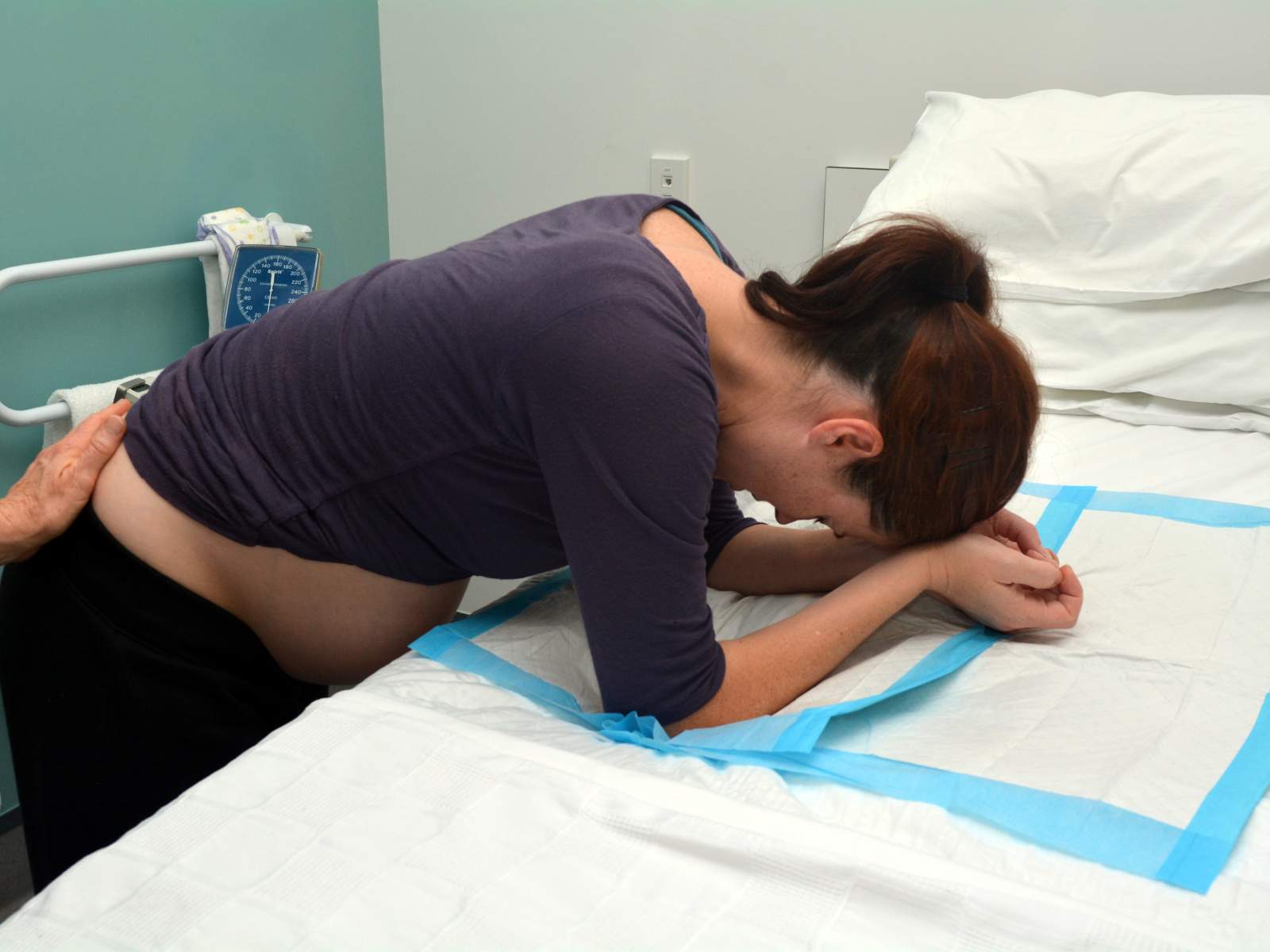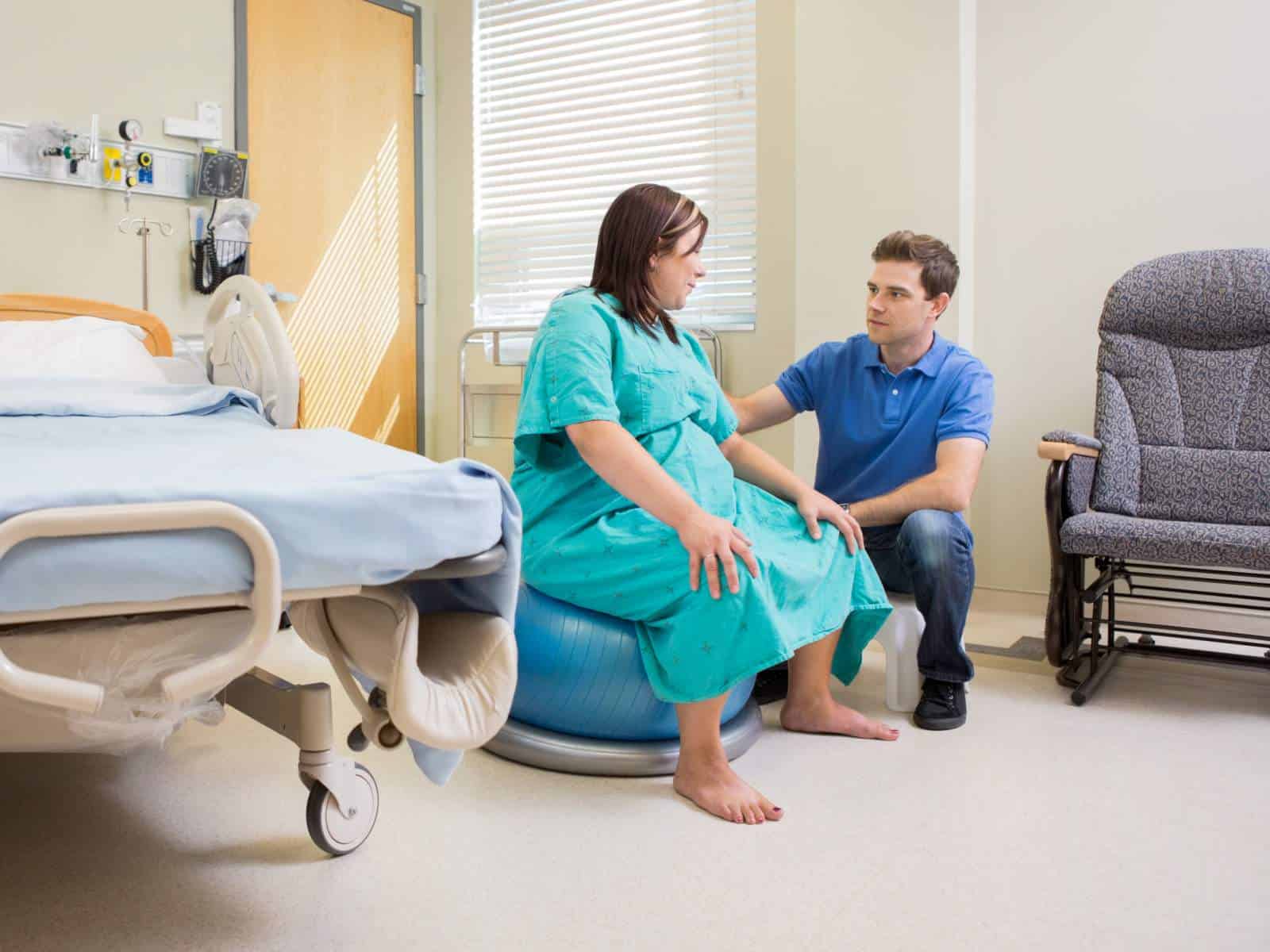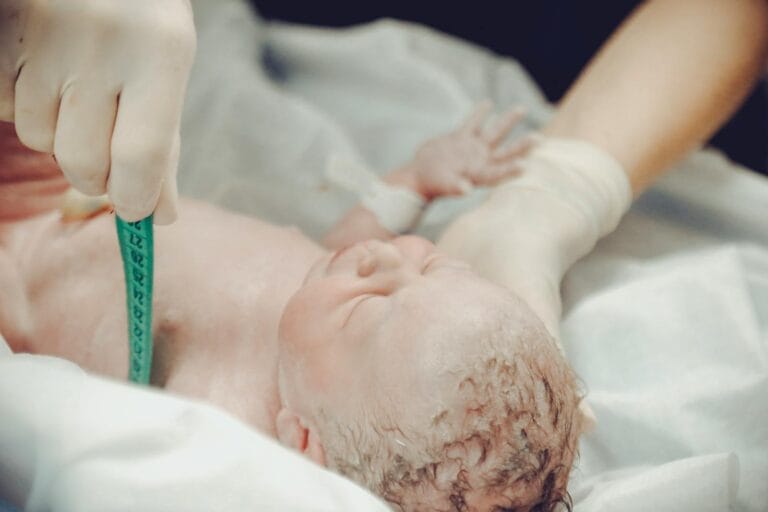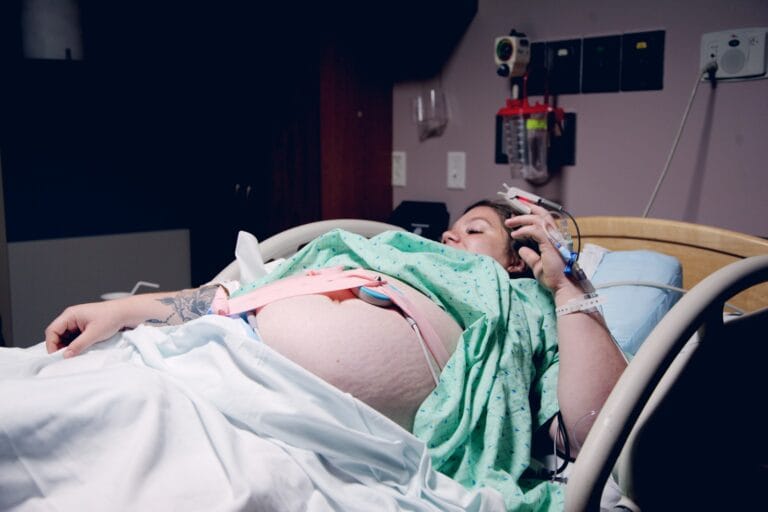How Painful is Natural Birth: Tips From a Mom Who Had An Unmedicated Birth
Unmedicated childbirth offers tons of benefits for you and your baby. But how painful is natural birth, really? Can you actually cope with it? Written by a mom of two, this article shares a little of what to expect from an unmedicated birth, plus effective pain-coping strategies to minimize discomfort.
If you’re reading this, you’re probably reaching the end of your pregnancy journey. Congratulations! It’s hard to believe that a few short months ago, your little one was the size of a mustard seed. Now she’s performing karate chops on your ribcage every chance she gets!
If you decided to labor without anesthesia, there’s probably one burning question on your mind right now: “How painful is natural birth, really?”
I obsessed over this question during my final weeks of pregnancy. What I was really wondering was, “Can I endure it?”
Here’s the truth: every birth experience is unique, and pain is subjective. While some women may describe labor as incredibly painful, others may use words like intense, powerful, or even transformative (that last one’s a bit of a stretch for me though).
The point is, it varies from woman to woman and even from pregnancy to pregnancy.
Below, I’ll share the different aspects of labor that causes pain, because inevitably, each phase of labor causes a different pain with varying degrees of intensity. I’m also going to share my favorite techniques and resources for coping with labor pain.
RELATED POSTS:
- What to Avoid if You Want to Go Natural
- The Mama Natural Birth Course Review
- The Kopa Prepared Online Birth Course Review

What I Mean By a “Natural Birth”
First things first, let me clarify what I mean by “natural birth.” In this post, I’m referring to giving birth without medical interventions, such as pain medications or epidurals.
In our modern age, this type of birth plan might seem a little crazy. This might sound a little cliché, but natural birth is all about the journey. You’re about to experience something beautiful. And this might sound even more cliché , but you might actually enjoy it.
The Physical Pain
The physical pain during my first birthing experience was awful. I requested an epidural after 19 hours of suffering.
The next pregnancy, I trained like it was a marathon. I took a fantastic natural birth class, exercised regularly, and came to the hospital prepared.
The results? my entire labor (from first contraction to crowning) was 14 hours and the pain was completely tolerable. Same woman, two completely different experiences.
I attribute part of my success to being better prepared for each phase of labor. I knew what to expect, so I didn’t freak out as much when it happened. And fear? That’s the destroyer of a natural childbirth experience.
Hopefully this knowledge will help you as well.
Contractions
Contractions and childbirth pains are pretty much synonymous. These are the rhythmic waves that guide your baby through the birth canal.
If you’re past 36 weeks, you’re probably very familiar with the “practice” version: “Braxton Hicks.” However, if you’re still not sure what they feel like…The easiest way to describe it is a VERY intense period cramp.
Let me give you another scenario.
Imagine you’re driving home from a BBQ joint after devouring a glorious brisket. Then you get the dreaded stomach cramp that signals its time to find a bathroom NOW. Of course, you’re five miles from home. So, you keep driving. The cramp eases and you thank God with every fiber of your being. A mile down the road, it comes back. This time its worse than before. This continues until you either, a., find a toilet or…you don’t. :/
That’s kind of what a contraction feels like. They’re rhythmic and gradually intensifying. And, like our little story, they serve the purpose of pushing stuff out.
At first, the cramps will be lightly uncomfortable. When you enter active labor though, they’ll hurt.
Sorry, there’s no way around it. Thankfully though, they only last about 30-70 seconds before you get a rest period.
This is the foundation for every natural childbirth class out there. Contractions are long and exhausting, but they’re bearable for most women if you prepare beforehand. Knowing how to deal with that pain, not fear it, and minimize it, is key to a natural birthing experience.
Below, we’ll talk a bit about how to cope with this pain. For now, my best tip is to find an excellent natural birth course that will teach you how to. You’ll be grateful you did!
I’ve taken many natural birth courses, but I found the Mama Natural Birth Course the easiest and most helpful for dealing with painful contractions.
Back Labor
During your delivery you might experience “pressure” on your lower back that ranges from mildly painful to excruciating.
This particular fiery level of hell is called “back labor.” More than likely, your baby’s head is pushing against your pelvis. It will probably intensify when your contraction hits and continue on (albeit a lesser degree) until your baby moves into a different position.
I experienced back labor in both of my childbirth experiences when my daughters were posterior. The first round, I went a little crazy (even with an epidural). The second time, I recognized what was happening and took charge. We eased this pain with the use of a rebozo and counter-pressure. I also found that getting on all fours greatly helped. This allowed my baby to turn into the optimal birthing position, which inevitably, cured the back labor.
Back labor isn’t something to fear, because if you can figure out how to work with it, you can overcome it. If it happens to you, just focus on figuring out something that eases the pain.
Pushing
Looking back, I would say that it’s the most painful phase, but also the quickest. Your mind and body sort of clicks because some primal part of you realizes that this pain serves a purpose.
Alternatively, this might be the phase where you tell your birth partner that you absolutely can’t do it and demand to go home.
Once you’re past 10cm and you’re able to push, generally you wait until you feel the contraction (which, ironically, no longer feels nearly as painful), and you bear down.
Pushing feels similar to pooping, except you’ll feel incredible pressure. For me, the hard part of the pushing process was pausing to catch a breath. Pausing hurts. Your birth canal is stretched to its capacity and you want the baby out NOW.
But, pausing and catching a breath can actually be very helpful. It allows you to gather your strength, helps your perineum stretch, and it allows you to wait until the next contraction (which results in a more efficient push).
Perineal Stretching and the “Ring of Fire” Sensation
As the baby progresses through the birth canal, the perineal area undergoes a sensation often described as the “ring of fire.” Look, there’s no better way to describe it. This part freaking stings.
If you’re feeling this sensation then congratulations, your baby is crowning and your labor is almost over! At this point, your baby’s head is stretching the skin of your vaginal opening.
Try pinching your skin and pulling it. Imagine that feeling magnified by 1000. That’s sort of what the “Ring of Fire” feels like.
When you feel “the ring of fire”, stop pushing immediately. Ask your provider to give you a perineal massage or apply a warm cloth to ease the pain. Anything to give your perineum a chance to stretch before it tears.
This pain is tough, but it only lasts for about 20 seconds.
Exhaustion

I remember a point in labor where exhaustion made the pain sharper. I was so sore and tired that I fell asleep in between contractions. When you reach this phase, just know that you’re almost there. It’s your body’s way of giving you a rest before the big finale!
Birthing of the Placenta
Compared to the rest of the pain of natural birth, pushing out your placenta feels pretty minimal. However, you’ll probably feel a couple uncomfortable cramps and another pressure before it comes out.
Emotional and Other Factors
Fear and Anxiety Surrounding Labor Pain
Fear increases your labor pain. Studies have proven it. I can attest to that statement. So, by conquering your fear, you’ll not only have a much more enjoyable childbirth experience, you may have a less painful one.
Be aware of the pain, the risks, and your circumstances, but don’t fear it.
Prepare, but don’t worry.
Genevieve from the Mama Natural Birth Course talked about an instance where a woman gave birth with virtually no labor pain. She was so chill and completely at ease that the baby seemed to just roll out of her body.
Now, that situation might be a little difficult to recreate. However, it makes sense. The cervix, like the anus, is a sphincter. When the sphincter is stressed, it closes. When you’re relaxed, it relaxes.
I know relaxation is harder said that done. Below we talk about relaxation techniques and deep breathing exercises. The goal is to help your muscles loosen, so they can do what they are designed to do.
Induced Labors
Just to be clear, this section is not to shame women that require some sort of birth augmentation. Sometimes an induced labor is necessary. There’s no shame in it. However, from personal experience, I can say that an induced labor can be more painful.
Genevieve also talked about that in the birth course. With a natural birth, labor begins somewhat slowly and gradually builds. Your cervix has time to open and thin. However, when you’re induced, contractions start more quickly and are a lot stronger. Unfortunately, this doesn’t equate to more productive. Induced labors often lead to more medical interventions, such as epidurals, forceps, and more.
How to Manage Pain During Natural Childbirth
If you’re going to go through your labor and delivery without pharmeceuticals, it’s important that you’re familiar with effective pain management techniques.
I could write an entire blog post about this, but for now here’s a few of my favorite strategies to get you started.
Distraction
This is, by far, my favorite technique for overcoming early contractions.
During my second pregnancy, my first contraction hit at 3AM. Intentionally, I went back to sleep. By 8AM, I gritted my teeth through the contractions and got my daughter ready for breakfast. At 9AM, I made a quiche. By 9:30, I was panting through my contraction. We decided it was time to go to the hospital. When we got there, we discovered that I was 5cm! Woo-hoo! That’s half my labor over already!
The moral of the story: when you start feeling regular contractions, don’t run to the hospital. Keep track of them, but focus on other things until…you can’t.
When you’re distracted, you’re not focusing on the pain. When you’re moving, you’re moving things downward. However, when you focus on the pain, it always feels worse.
Breathing Techniques
If you want to go natural, I highly recommend familiarizing yourself with different breathing techniques.
Breathing techniques not only help you manage pain, but they also offer a multitude of additional benefits during childbirth:
- Increased Oxygen: Deep breaths optimize oxygen intake, which promotes relaxation, reduces fatigue, and supports your baby.
- Distraction: Conscious breathing distracts your mind from the pain, and requires you to pay attention to how you breathe and your muscle relaxation.
- Endorphins: Rhythmic breathing triggers the release of endorphins, which–you guessed it–are natural pain relievers!
Lamaze Breathing
Lamaze breathing is probably the most popular breathing technique to manage pain during labor. It involves finding a rhythmic pattern, syncing your breath to contractions, and focusing on your inner calm. By breathing in through your nose and out through your mouth, you can establish a steady flow of oxygen. Ideally, you’ll release tension with each exhale.
Students of lamaze classes count as they exhale and inhale. Honestly, this type of breathing technique wasn’t my thing (I could never remember the patterns), but it works for a lot of women!
If calculated breaths is your style, you need to check out The KOPA Prepared Natural Childbirth class. Kate offers the most in-depth, step-by-step breathing tutorials I’ve ever seen, plus guided relaxation techniques. This course is very different from the Mama Natural Birth Course. If you’re more on the analytical side and love have a “blueprint” for labor, that’s probably the best natural prenatal class for you!
RELATED POST: The Kopa Prepared Natural Childbirth Class
Deep Breathing
By taking slow, deep breaths, you can activate the body’s relaxation response, reducing stress and tension. Imagine filling your abdomen with air as you inhale, allowing your breath to flow deep into your belly, and exhaling slowly, releasing any tension with each breath.
I recommend using this technique in the early stages of labor.
Guided breathing clips on Youtube (or in the KOPA Prepared Birth Class) are really helpful for this!
Patterned Breathing
Different breathing techniques will be effective during different phases of labor.
- Slow-Paced Breathing: This is very similar to deep breathing. The focus is on taking deep breaths and allowing your body to relax. Once again, the goal is to relax. This will be most helpful for early labor.
- Modified-Paced Breathing: You’re going to reach a point when deep breathing exercises are no longer effective. You’ll need to focus on a “pant-pant-blow” during the peak of contractions and return to slow breaths during the rest period.
- Cleansing Breath: You can use cleansing breaths after every contractions and also during the pushing phase. A cleansing breath is just a forceful exhale and strong inhale that releases tension.
Once again, I loved Mama Natural Birth Course’s tutorials for showing all of these techniques. I also loved the birthing videos she includes in her course. When I watched them, I felt a little awkward, but during my actual labor, my half-crazed brain appreciated the first-hand tutorials!
Relaxation Exercises
When I was 36 weeks pregnant and my birth class instructor told me that one of the best exercises to progress labor was merely relaxation, I was a little skeptical. I mean, I was a first-time mom, terrified of the birthing process, and already experiencing uncomfortable braxton hicks contractions.
And you want me to relax? Right.
But…now on the other side, I agree. Muscle relaxation helps progress labor a lot. However, like training for a marathon, you really need to train to relax in stressful and, yes, painful, situations.
You can try a few relaxation techniques to accomplish this:
- Progressive Muscle Relaxation
- Guided Imagery
- Meditation and Mindfulness Techniques
Movement and Position Changes

Movement helps your baby wiggle down the birth canal. Essentially, it allows you to use gravity in your favor and move your baby down the birth canal. Conversely, when you’re laying down, you’re restricting your baby’s space.
Likewise, changing up your labor positions offers pain relief for your varying stages of labor.
There will also be a moment in your labor where the pain will feel too intense to handle. That’s a good cue to switch positions or walk around. When I gave birth naturally, that trick almost always made the pain bearable.
Here are a few of the labor positions that were the most effective for me:
- Hip rotations on the exercise ball
- On all fours (alternatively, sometimes I would move into kind of a downward-facing dog position)
- Squatting
- Swaying
- Kneeling against birthing ball
In addition to practicing these techniques beforehand, I would keep a list (with actual pictures) of these positions in your hospital bag. My labor-crazed brain referred back to them constantly.
Counter-Pressure
If you don’t have a birth partner, please find one. Whether that looks like a friend, family member, doula, or midwife. Yes, you can absolutely give birth by yourself (with the help of your health care provider obviously), but there are just things you can’t do that alleviate pain greatly.
For example, The Mama Natural Birth Course teaches a fantastic counter-pressure move where your birth partner basically presses hard into your sacrum (or another place in your lower back). This technique–by far–-was one of the best methods of relieving birth pain. I do not think I could’ve survived without it.
FAQ
How painful is natural birth compared to other methods?
When you have an epidural, you can barely feel the pain at all. Literally, from your waist down, nothing. In contrast, you feel everything during natural birth. The good and the bad. Truly, it’s a double-edged sword.
Can I have a natural birth without experiencing extreme pain?
That depends on you, your baby, and the circumstances of your labor. Some women naturally do not experience as much pain. Some babies are perfectly aligned in the womb for childbirth. And some women experience unfortunate circumstances that increase the intensity of their childbirth pains (Pitocin inductions, for example).
Your best bet to prepare beforehand. Take a natural childbirth class. Learn the relaxation techniques and best birthing positions. Eat foods that ripen your cervix. Exercise regularly.
In my birth class, Genevieve recommended eating dates regularly. Studies show that dates can ripen your cervix beforehand, which may lead to an easier labor. I tried this (plus some other techniques) and my labor went much quicker than the first round! I just felt ready.
What’s the Benefits of an Unmedicated Vaginal Birth?
It’s important to understand the benefits of natural birth before you commit to it. Mostly likely you’re going to need to cling to these benefits to motivate you during labor.
- Freedom of movement: Once you get an epidural, that’s it. You’ll most likely be stuck in your bed until your baby is delivered. In contrast, movement helps you dilate and increases circulation (both of which are extremely beneficial to your baby!)
- It can move labor along: This isn’t always the case, but many times giving birth without medications can progress your labor faster. Remember, movement=faster, more seamless labor.
- Lowers the risk of more medical interventions: While studies have found that epidurals do not increase the chances of a c-section, it has been found that they increase the chances of further medical interventions (fetal heart monitors, forceps, etc.).
- Can increase your baby’s apgar score: without an epidural, your baby is more alert and receives more oxygen-rich blood
- Helps with breastfeeding: Studies have shown that babies born from an epidural labor may be less aware and drowsy. This can hinder your initial breastfeeding session. Not only that, studies have found that prolactin levels in women that receive an epidural are significantly lower.
- Enhances your emotional connection: While I love both of my daughters equally, I was able to experience a very special bond with my second daughter after my labor. I firmly believe that was because of the lack of drugs. Studies show that a natural birth may help your body to produce endorphins and oxytocin more efficiently.
- You feel like a rockstar: It’s like a runners high. There’s a sense of empowerment afterward that can’t be replicated.
- Faster recovery time: For one, you’ll be able to pee by yourself immediately. For another, sometimes the sight where they stick you for the epidural can get nerve-damage. That hurts. You’ll also experience improved energy levels and awareness during those first few hours that are critical for healing.
What if I change my mind about natural birth during labor?
When you’re giving birth in a hospital, you can most likely receive an epidural until your baby crowns. Just keep in mind that it usually takes about 20 minutes to set the epidural up, and then another 20 minutes for an epidural to kick in.
The only instance that might be tricky is if you’re giving birth at home or in a natural birthing facility. In that case, you would need to be transferred to a hospital.
How can I manage the pain during childbirth if I have a low pain tolerance?
I have a pretty low pain tolerance. At the very least, I can stand very little of it before I start complaining.
In my opinion, preparation is key. If you focus on learning pain coping skills and going into this with a casual attitude, it’s one million times easier.
A line that was hugely helpful to me during labor: I can do anything for 15 seconds. This got me through the worst contractions. When it was done, I thought about how that contraction moved my baby to the finish line. That’s the other thing you should focus on: this pain isn’t unproductive. It serves a purpose. Your body is actively pushing your baby out. That might not mean a lot to you right now, but it will when you’re in labor.
Unmedicated birth is a mental game.
Is a Natural Childbirth Worth The Pain?

In my opinion, yes. The experience was incredible, and even now, three years later, I still look back on the experience and smile. Yes, I still remember the pain. It hurt. A lot. But I was there for all of it and the thrill afterward made it completely worthwhile.
The emotional experience was completely different as well. Above, we talked about how an unmedicated birth promotes endorphins and oxytocin. I 100% experienced that after mine. It helped me connect with my daughter in a way that was completely different than my first.
I completely believe that educating yourself before you go into this makes or breaks a natural labor. Not only do birth classes teach you important coping strategies, but understanding the birthing process will knock fear onto its butt. It will help you feel more prepared for your own labor. In this article, I talked a lot about the Mama Natural Birth Course. That was a great fit for my personality, but there are others available that may fit better with your learning style and budget.
I have taken a lot of childbirth classes, so I compiled a list of the best ones on the internet. Please, check out some of my favorites and decide which ones are best for you.
Having said that, there is no wrong way to give birth. Seriously. Both of my birthing experiences were beautiful. My relationship with both of my girls is wonderful.
Remember, the method of giving birth will become an afterthought when your baby arrives. So, make a plan, dream a little, but move into this experience with an open mind. Ultimately, the best way to experience childbirth is how YOU give birth.
RELATED POSTS: The Best Online Prenatal Courses






